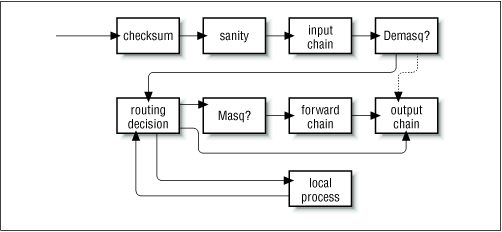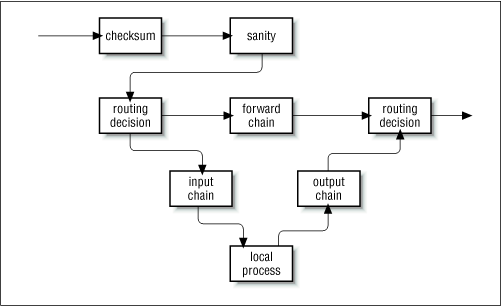Книга: Linux Network Administrator Guide, Second Edition
Netfilter and IP Tables (2.4 Kernels)
While developing IP Firewall Chains, Paul Russell decided that IP firewalling should be less difficult; he soon set about the task of simplifying aspects of datagram processing in the kernel firewalling code and produced a filtering framework that was both much cleaner and much more flexible. He called this new framework netfilter.
NOTE: At the time of preparation of this book the netfilter design had not yet stabilized. We hope you'll forgive any errors in the description of netfilter or its associated configuration tools that result from changes that occurred after preparation of this material. We considered the netfilter work important enough to justify the inclusion of this material, despite parts of it being speculative in nature. If you're in any doubt, the relevant HOWTO documents will contain the most accurate and up-to-date information on the detailed issues associated with the netfilter configuration.
So what was wrong with IP chains? They vastly improved the efficiency and management of firewall rules. But the way they processed datagrams was still complex, especially in conjunction with firewall-related features like IP masquerade (discussed in Chapter 11) and other forms of address translation. Part of this complexity existed because IP masquerade and Network Address Translation were developed independently of the IP firewalling code and integrated later, rather than having been designed as a true part of the firewall code from the start. If a developer wanted to add yet more features in the datagram processing sequence, he would have had difficulty finding a place to insert the code and would have been forced to make changes in the kernel in order to do so.
Still, there were other problems. In particular, the "input" chain described input to the IP networking layer as a whole. The input chain affected both datagrams to be destined for this host and datagrams to be routed by this host. This was somewhat counterintuitive because it confused the function of the input chain with that of the forward chain, which applied only to datagrams to be forwarded, but which always followed the input chain. If you wanted to treat datagrams for this host differently from datagrams to be forwarded, it was necessary to build complex rules that excluded one or the other. The same problem applied to the output chain.
Inevitably some of this complexity spilled over into the system administrator's job because it was reflected in the way that rulesets had to be designed. Moreover, any extensions to filtering required direct modifications to the kernel, because all filtering policies were implemented there and there was no way of providing a transparent interface into it. netfilter addresses both the complexity and the rigidity of older solutions by implementing a generic framework in the kernel that streamlines the way datagrams are processed and provides a capability to extend filtering policy without having to modify the kernel.
Let's take a look at two of the key changes made. Figure 9.8 illustrates how datagrams are processed in the IP chains implementation, while Figure 9.9 illustrates how they are processed in the netfilter implementation. The key differences are the removal of the masquerading function from the core code and a change in the locations of the input and output chains. To accompany these changes, a new and extensible configuration tool called iptables was created.
In IP chains, the input chain applies to all datagrams received by the host, irrespective of whether they are destined for the local host or routed to some other host. In netfilter, the input chain applies only to datagrams destined for the local host, and the forward chain applies only to datagrams destined for another host. Similarly, in IP chains, the output chain applies to all datagrams leaving the local host, irrespective of whether the datagram is generated on the local host or routed from some other host. In netfilter, the output chain applies only to datagrams generated on this host and does not apply to datagrams being routed from another host. This change alone offers a huge simplification of many firewall configurations.
Figure 9.8: Datagram processing chain in IP chains

In Figure 9.8, the components labeled "demasq" and "masq" are separate kernel components responsible for the incoming and outgoing processing of masqueraded datagrams. These have been reimplemented as netfilter modules.
Consider the case of a configuration for which the default policy for each of the input, forward, and output chains is deny. In IP chains, six rules would be needed to allow any session through a firewall host: two each in the input, forward, and output chains (one would cover each forward path and one would cover each return path). You can imagine how this could easily become extremely complex and difficult to manage when you want to mix sessions that could be routed and sessions that could connect to the local host without being routed. IP chains allow you to create chains that would simplify this task a little, but the design isn't obvious and requires a certain level of expertise.
In the netfilter implementation with iptables, this complexity disappears completely. For a service to be routed across the firewall host, but not terminate on the local host, only two rules are required: one each for the forward and the reverse directions in the forward chain. This is the obvious way to design firewalling rules, and will serve to simplify the design of firewall configurations immensely.
Figure 9.9: Datagram processing chain in netfilter

The PACKET-FILTERING-HOWTO offers a detailed list of the changes that have been made, so let's focus on the more practical aspects here.
- Разработка приложений баз данных InterBase на Borland Delphi
- Open Source Insight and Discussion
- Introduction to Microprocessors and Microcontrollers
- Chapter 6. Traversing of tables and chains
- Chapter 8. Saving and restoring large rule-sets
- Chapter 10. Iptables matches
- Chapter 11. Iptables targets and jumps
- Chapter 5 Installing and Configuring VirtualCenter 2.0
- Chapter 15. Graphical User Interfaces for Iptables
- Chapter 16. Commercial products based on Linux, iptables and netfilter
- Appendix A. Detailed explanations of special commands
- Appendix B. Common problems and questions




